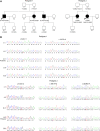Compound Heterozygous Variants of the CPAMD8 Gene Co-Segregating in Two Chinese Pedigrees With Pigment Dispersion Syndrome/Pigmentary Glaucoma
- PMID: 35957697
- PMCID: PMC9358689
- DOI: 10.3389/fgene.2022.845081
Compound Heterozygous Variants of the CPAMD8 Gene Co-Segregating in Two Chinese Pedigrees With Pigment Dispersion Syndrome/Pigmentary Glaucoma
Abstract
The molecular mechanisms underlying the pathogenesis of pigment dispersion syndrome and pigmentary glaucoma remain unclear. In pedigree-based studies, familial aggregation and recurrences in relatives suggest a strong genetic basis for pigmentary glaucoma. In this study, we aimed to identify the genetic background of two Chinese pedigrees with pigmentary glaucoma. All members of these two pedigrees who enrolled in the study underwent a comprehensive ophthalmologic examination, and genomic DNA was extracted from peripheral venous blood samples. Whole-exome sequencing and candidate gene verifications were performed to identify the disease-causing variants; in addition, screening of the CPAMD8 gene was performed on 38 patients of sporadic pigmentary glaucoma. Changes in the structure and function of abnormal proteins caused by gene variants were analyzed with a bioinformatics assessment. Pigmentary glaucoma was identified in a total of five patients from the two pedigrees, as were compound heterozygous variants of the CPAMD8 gene. No signs of pigmentary glaucoma were found in carriers of monoallelic CPAMD8 variant/variants. All four variants were inherited in an autosomal recessive mode. In addition to the 38 patients of sporadic pigmentary glaucoma, 13 variants of the CPAMD8 gene were identified in 11 patients. This study reported a possible association between CPAMD8 variants and pigment dispersion syndrome/pigmentary glaucoma.
Keywords: CPAMD8; autosomal recessive inheritance; compound heterozygous variant; pedigree; pigmentary glaucoma.
Copyright © 2022 Tan, Zeng, Wang, Liu, Huang, Chen, Wang, Fan, He and Liu.
Conflict of interest statement
The authors declare that the research was conducted in the absence of any commercial or financial relationships that could be construed as a potential conflict of interest.
Figures



Similar articles
-
Biallelic CPAMD8 Variants Are a Frequent Cause of Childhood and Juvenile Open-Angle Glaucoma.Ophthalmology. 2020 Jun;127(6):758-766. doi: 10.1016/j.ophtha.2019.12.024. Epub 2020 Jan 7. Ophthalmology. 2020. PMID: 32085876
-
DNA sequence variants in the tyrosinase-related protein 1 (TYRP1) gene are not associated with human pigmentary glaucoma.Mol Vis. 2002 Apr 24;8:127-9. Mol Vis. 2002. PMID: 12011806
-
Biallelic variants in CPAMD8 are associated with primary open-angle glaucoma and primary angle-closure glaucoma.Br J Ophthalmol. 2022 Dec;106(12):1710-1715. doi: 10.1136/bjophthalmol-2020-318668. Epub 2021 Jun 21. Br J Ophthalmol. 2022. PMID: 34154991
-
CPAMD8 loss-of-function underlies non-dominant congenital glaucoma with variable anterior segment dysgenesis and abnormal extracellular matrix.Hum Genet. 2020 Oct;139(10):1209-1231. doi: 10.1007/s00439-020-02164-0. Epub 2020 Apr 9. Hum Genet. 2020. PMID: 32274568
-
[Role of laser peripheral iridotomy in pigmentary glaucoma and pigment dispersion syndrome: A review of the literature [French version]].J Fr Ophtalmol. 2017 Dec;40(10):889-897. doi: 10.1016/j.jfo.2017.04.006. Epub 2017 Oct 16. J Fr Ophtalmol. 2017. PMID: 29050926 Review. French.
Cited by
-
Congenital anterior segment ocular disorders: Genotype-phenotype correlations and emerging novel mechanisms.Prog Retin Eye Res. 2024 Sep;102:101288. doi: 10.1016/j.preteyeres.2024.101288. Epub 2024 Aug 2. Prog Retin Eye Res. 2024. PMID: 39097141 Review.
-
Lack of Association between LOXL1 Variants and Pigment Dispersion Syndrome/Pigmentary Glaucoma: A Meta-Analysis.Genes (Basel). 2024 Jan 26;15(2):161. doi: 10.3390/genes15020161. Genes (Basel). 2024. PMID: 38397151 Free PMC article.
-
Genetic Basis of Pigment Dispersion Syndrome and Pigmentary Glaucoma: An Update and Functional Insights.Genes (Basel). 2024 Jan 23;15(2):142. doi: 10.3390/genes15020142. Genes (Basel). 2024. PMID: 38397132 Free PMC article. Review.
References
-
- Bonet-Fernández J.-M., Aroca-Aguilar J.-D., Corton M., Ramírez A.-I., Alexandre-Moreno S., García-Antón M.-T., et al. (2020). CPAMD8 Loss-Of-Function Underlies Non-dominant Congenital Glaucoma with Variable Anterior Segment Dysgenesis and Abnormal Extracellular Matrix. Hum. Genet. 139 (10), 1209–1231. 10.1007/s00439-020-02164-0 - DOI - PubMed
LinkOut - more resources
Full Text Sources

